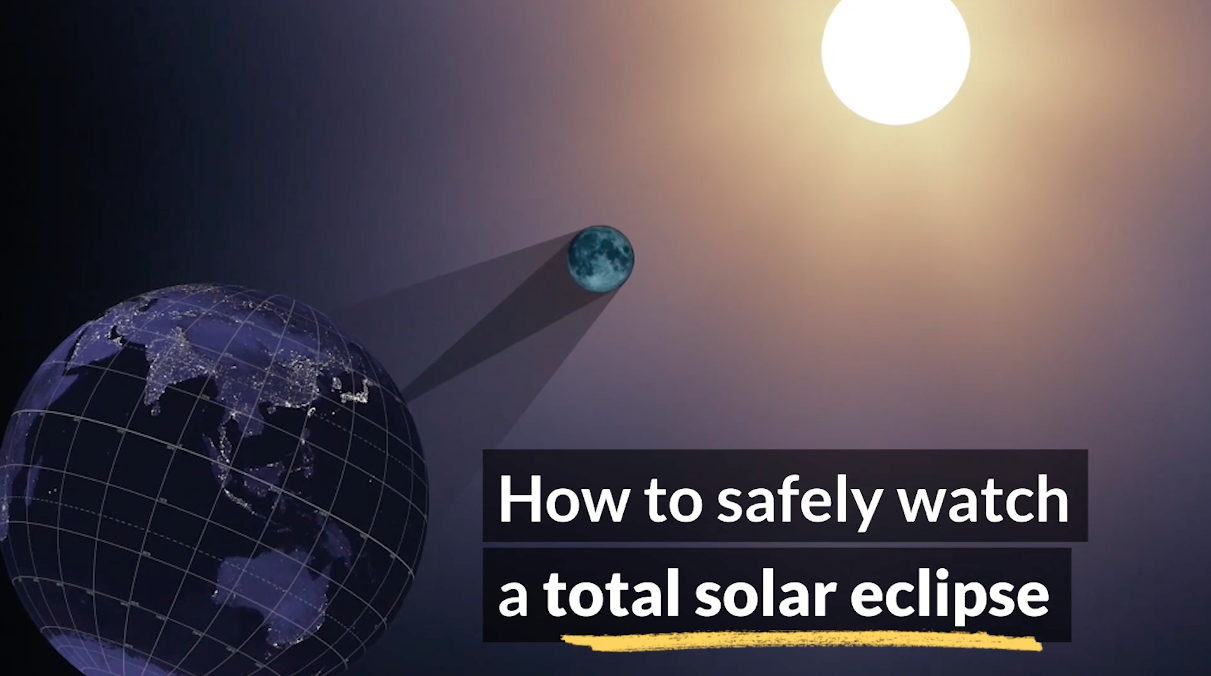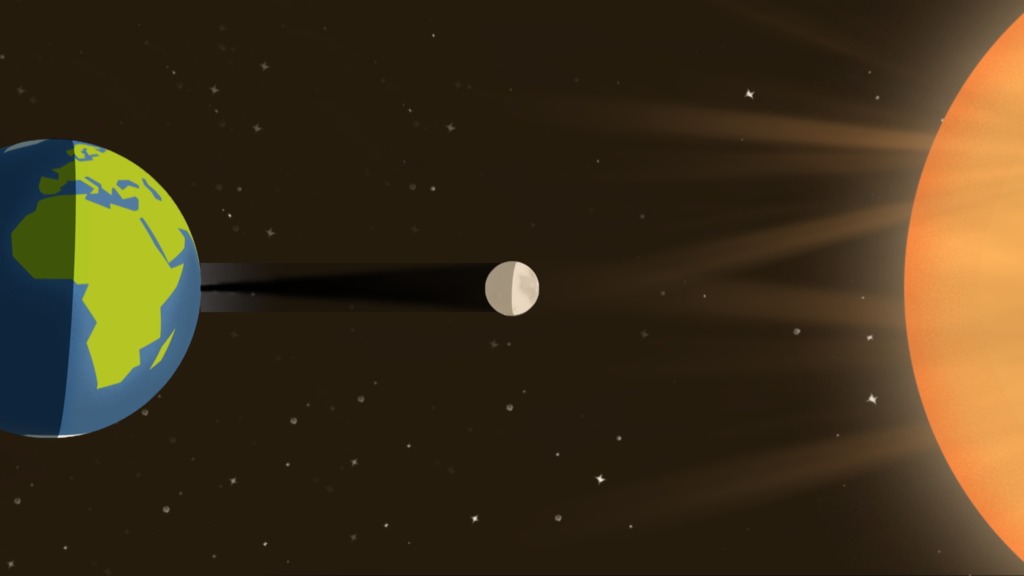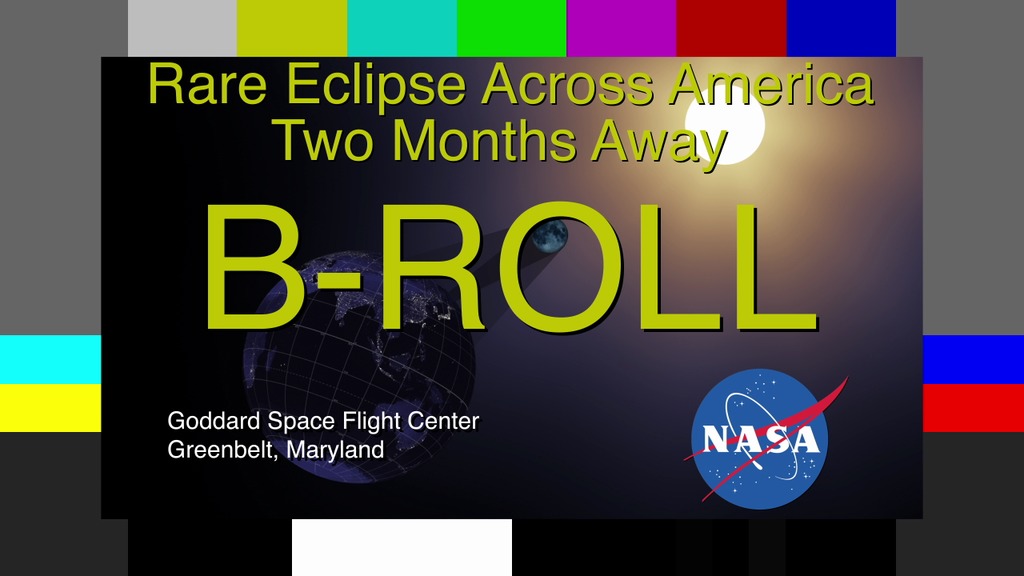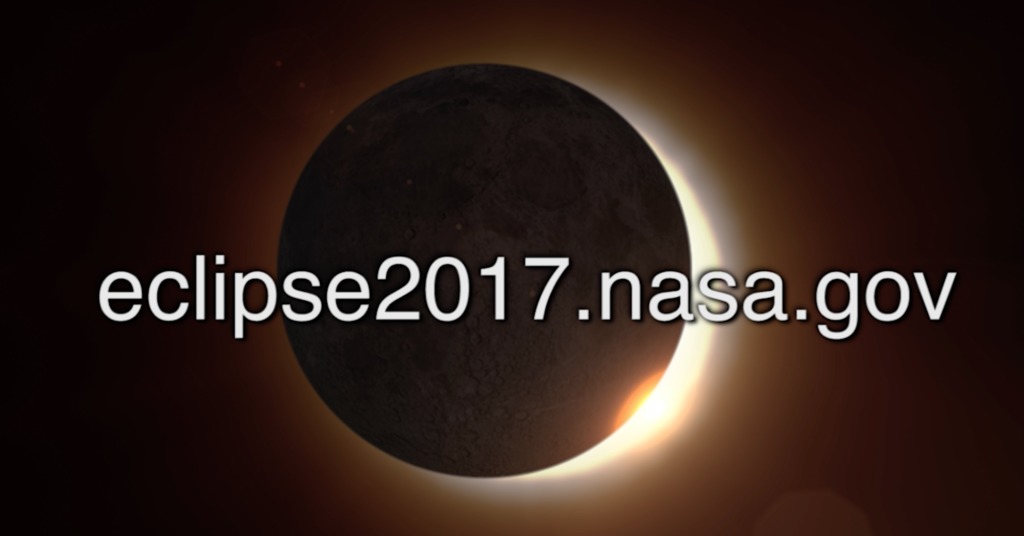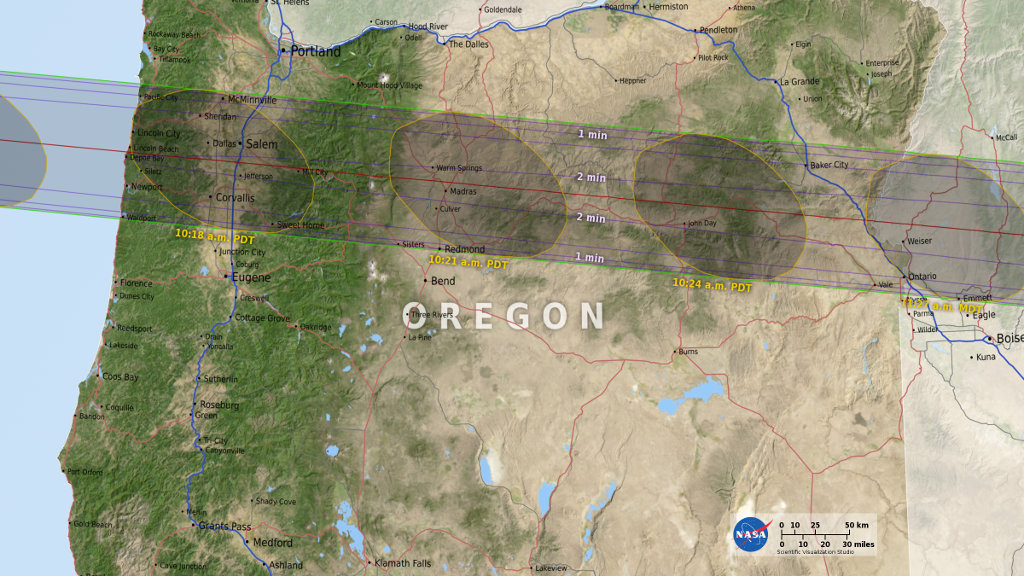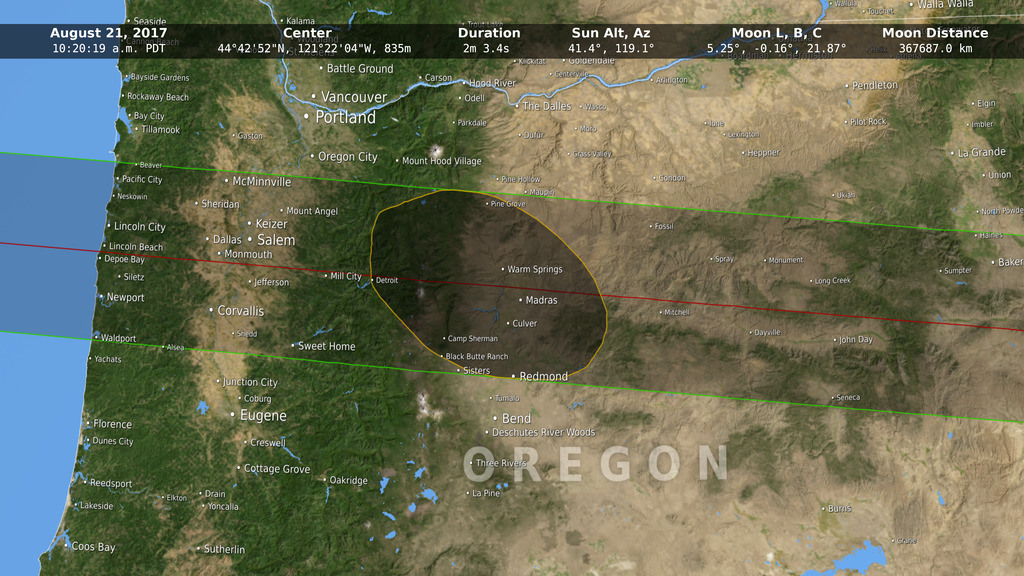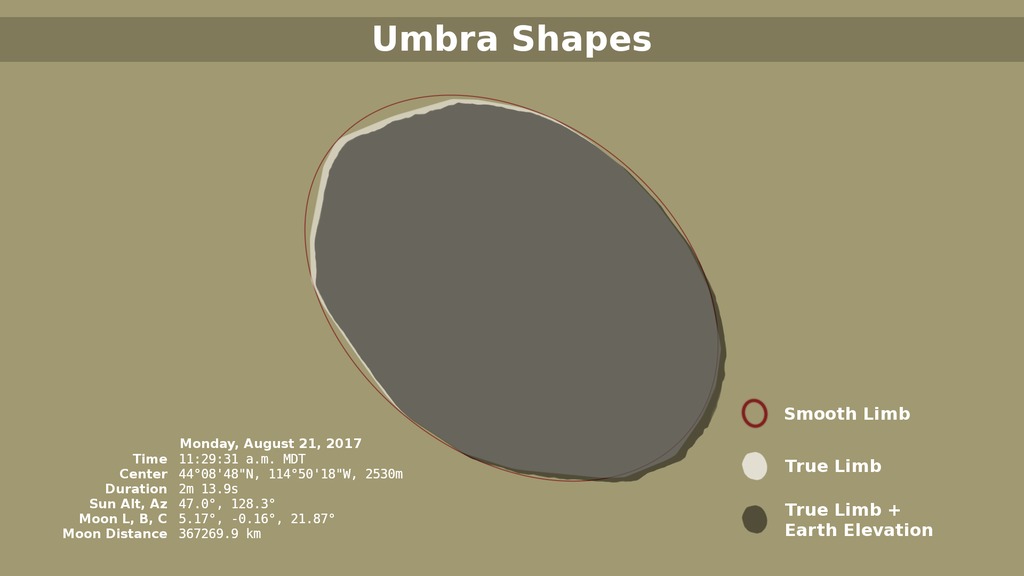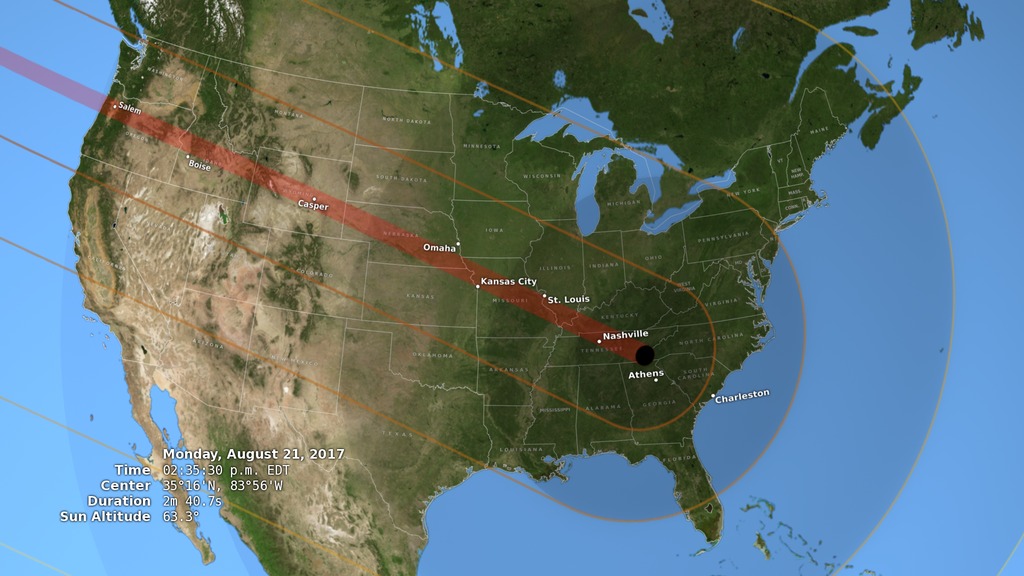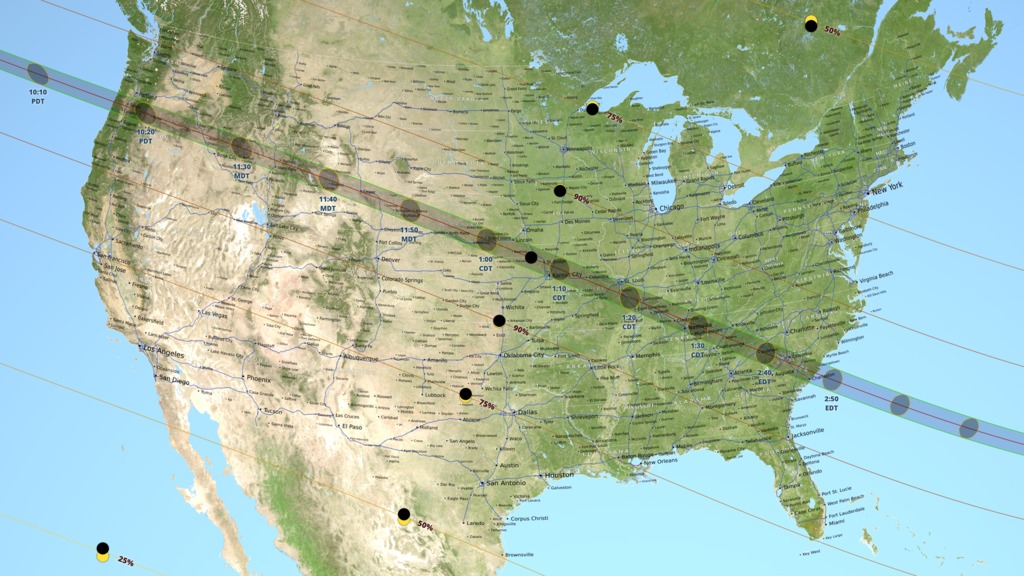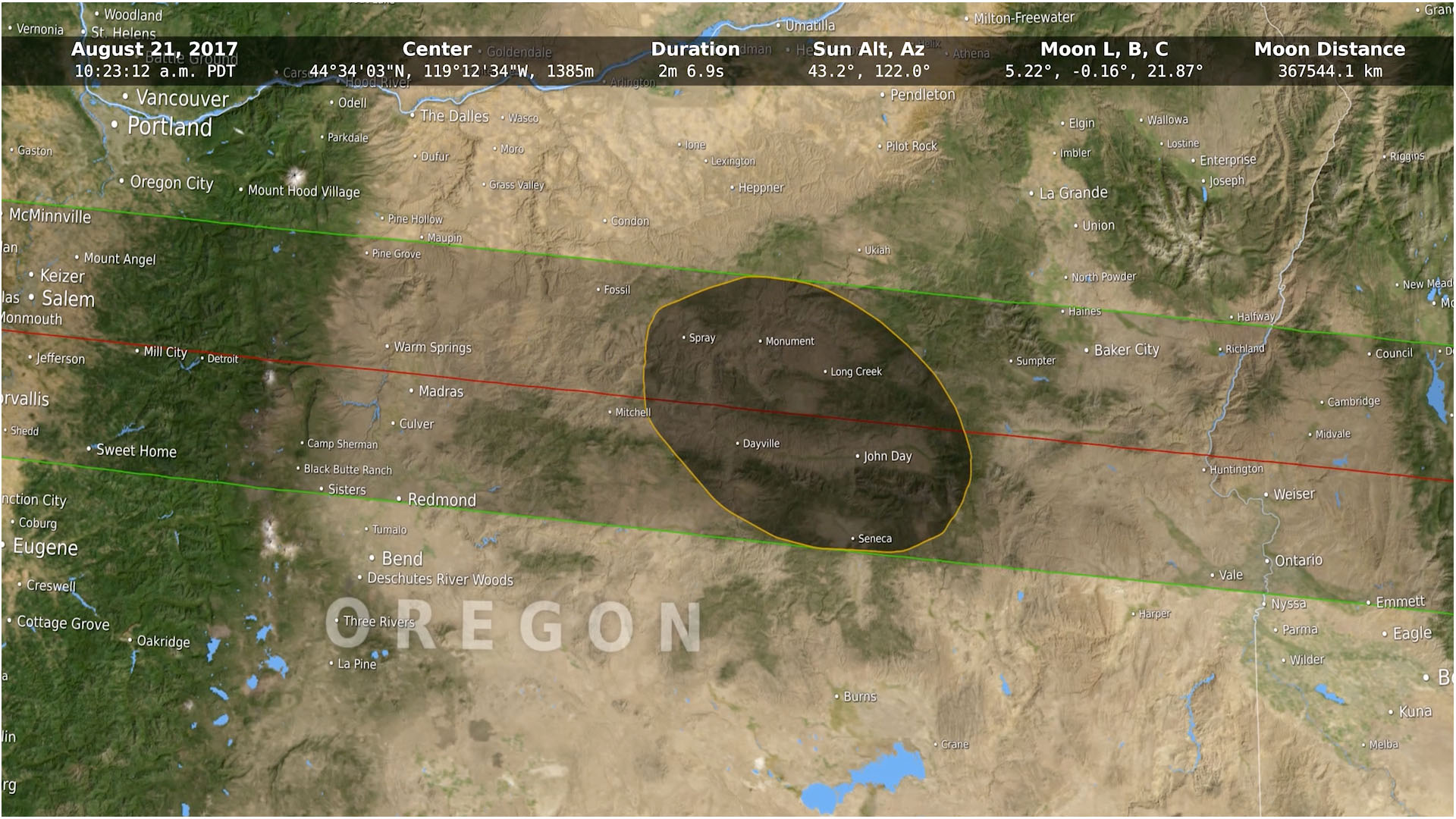2017 Total Solar Eclipse Map and Shapefiles

A map of the United States showing the path of totality for the August 21, 2017 total solar eclipse. This is version 2 of the map, available at both 5400 × 2700 and 10,800 × 5400.
This map of the United States shows the path of the Moon's umbral shadow — the path of totality — during the total solar eclipse on August 21, 2017, as well as the obscuration (the fraction of the Sun's area covered by the Moon) in places outside the umbral path. Features include state boundaries, major highways, and 833 place names. At 18" × 9" (45 × 22.5 cm), the scale of the map is approximately 1:10,000,000.
The umbra is shown at 10-minute intervals. Umbra shapes within U.S. time zones are labeled in local time. To read about the reason the shapes aren't smooth ovals, go here.
The map uses a number of NASA data products. The land color is based on Blue Marble Next Generation, a global mosaic of MODIS images assembled by NASA's Earth Observatory. Elevations are from SRTM, a radar instrument flown on Space Shuttle Endeavour during the STS-99 mission. Lunar topography, used for precise shadow calculations, is from NASA LRO laser altimetry and JAXA Kaguya stereo imaging. Planetary positions are from the JPL DE421 ephemeris. The lunar limb profile and eclipse calculations are by the visualizer.

A global map of the path of totality for the August 21, 2017 total solar eclipse.

A map of the United States showing the path of totality for the August 21, 2017 total solar eclipse.
Shapefiles
The map was rendered in animation software, but maps are more typically created using GIS tools and vector datasets. A set of shapefiles describing the umbra and penumbra extents is provided below in two Zip archives, one for global, U.S., and statewide maps and the other for county and city scale mapping.
The shapes of the umbra and penumbra, provided in ESRI shapefile format suitable for use in GIS software.
eclipse2017_shapefiles.zip contains the following nine shapefiles:
penum17 contains the contours for maximum obscuration at 90%, 75%, 50%, 25% and the penumbra edge at 0%.
penum17_1m contains a time sequence of penumbra outlines at 1-minute intervals from 17:00 to 19:15 UTC, for 95% to 75% obscuration in 5% steps.
upath17 and w_upath17 contain the path of totality. The w_ version is the complete (world) path, at somewhat reduced resolution, while the other is a high-resolution version of the path limited to the 96 degrees of longitude centered on the U.S.
umbra17 and w_umbra17 contain umbra shapes spaced at 10-minute intervals, again at U.S. and world (w_) scales.
w_umbra17_1m contains umbra shapes at 1-minute intervals from 16:49 to 20:02 UTC, covering the complete timespan of totality.
center17 and w_center17 contain the center line.
The projection for all of these shapefiles is WGS84, latitude-longitude, in degrees. A minimal .PRJ file reflecting this projection is included for each shape.

The umbra, path, and center line in shapefile format for use in GIS software. This shapefile set is intended for larger scale (higher resolution) mapping. The preview image shows the umbra at 90-second intervals as it passes through Nebraska.
eclipse2017_shapefiles_1s.zip is intended for larger-scale (higher resolution) mapping. It contains the following shapefiles:
umbra17_1s contains 6000 umbra shapes at one-second intervals from 17:12 to 18:52 UTC. These are high-resolution shapes with roughly 100-meter precision. The attributes for each shape include both a string representation of the UTC time and an integer containing the number of seconds past midnight of eclipse day.
upath17_1s contains the path of totality, limited to the extent of the 6000 umbra shapes, roughly the 54 degrees of longitude between 130°W and 76°W. The shape was calculated at a precision of 250 meters.
ucenter17_1s contains the center line as a polyline with points at one-second intervals.
durations17_1s contains shapefiles for duration of totality at 30-second intervals. As with the path, these shapes are truncated and invalid at the ends.
Future Eclipse
North America is treated to two continent-spanning total solar eclipses in the space of seven years. The 2024 path of totality stretches from Mexico and Texas to Maine. It's up to twice as wide as the 2017 path, and at over four minutes in most places, the duration is nearly twice as long. Major cities in the path include Dallas, Indianapolis, Cleveland, and Buffalo, with many more a relatively short distance away. The paths of the two eclipses cross in southern Illinois, near Carbondale. A more detailed map of the 2024 eclipse is available here.
A map of North America showing the crossing paths of the 2017 and 2024 total solar eclipses.
Past Eclipses
The last time a total solar eclipse spanned the contiguous United States was in 1918. The path of totality entered the U.S. through the southwest corner of Washington state and passed over Denver, Jackson (Mississippi) and Orlando before exiting the country at the Atlantic coast of Florida.
Map of the 1918 total solar eclipse, from the American Ephemeris and Nautical Almanac for the Year 1918. This is a scan from the copy of the almanac held by the NASA Goddard library.
Prior to 2017, the most recent total solar eclipse in the Lower 48 was in 1979. Totality was visible in Washington, Oregon, Idaho, Montana, and North Dakota, as well as parts of Canada and Greenland. The author saw this eclipse in Winnipeg, Manitoba.

Map of the 1979 total solar eclipse, from the American Ephemeris and Nautical Almanac. This is a scan from Ernie Wright's personal copy of U.S. Naval Observatory Circular No. 157.
For More Information
Credits
Please give credit for this item to:
NASA's Scientific Visualization Studio
-
Visualizer
-
Ernie Wright
(USRA)
-
Ernie Wright
(USRA)
Missions
This page is related to the following missions:Series
This page can be found in the following series:Datasets used
-
DEM [SRTM: SIR-C]
ID: 481 -
BMNG (Blue Marble: Next Generation) [Terra and Aqua: MODIS]
ID: 508Credit: The Blue Marble data is courtesy of Reto Stockli (NASA/GSFC).
This dataset can be found at: http://earthobservatory.nasa.gov/Newsroom/BlueMarble/
See all pages that use this dataset -
DEM (Digital Elevation Map) [LRO: LOLA]
ID: 653 -
DE421 (JPL DE421)
ID: 752Planetary ephemerides
This dataset can be found at: http://ssd.jpl.nasa.gov/?ephemerides#planets
See all pages that use this dataset -
SLDEM2015 (DIgital Elevation Model) [LRO/SELENE: LOLA/TC]
ID: 948A digital elevation model of the Moon derived from the Lunar Orbiter Laser Altimeter and the SELENE Terrain Camera. See the description in Icarus. The data is here.
See all pages that use this dataset -
North America Roads (Natural Earth: North America Roads)
ID: 968The 1:1,000,000 scale roads database for North America from Natural Earth: http://www.naturalearthdata.com/downloads/10m-cultural-vectors/roads/. This data is in the public domain. Terms of use: http://www.naturalearthdata.com/about/terms-of-use/.
See all pages that use this dataset
Note: While we identify the data sets used on this page, we do not store any further details, nor the data sets themselves on our site.
Release date
This page was originally published on Tuesday, December 13, 2016.
This page was last updated on Sunday, January 5, 2025 at 12:07 AM EST.

